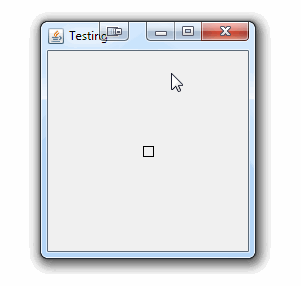

当我点击时,我试图将一个正方形从它的原始位置移动到我鼠标的坐标。我的代码有些工作,但是正方形不直接进入鼠标点击。它斜向有点偏离,然后进入鼠标点击,如图所示。我试图使它成为一条直线移动路径,但我想不出这样做的方法。我很确定错误与下面的第一种方法有关。
________X ← the mouse click
/
/ ↑
/ ← = movement path
/
/
_____/
| | ← character
|___|
以下是到目前为止涉及的3种方法(请不要过多批评我的代码)
//int x and int y are the positions of the mouse, champion = the character
public static Champion calculateChampionMovement(int x, int y, Champion champion) {
if (x != champion.x || y != champion.y) {
//x and y dist = the distance between the character and the cursor
int xDist = x - champion.x;
int yDist = y - champion.y;
//the angle
plrAngle = Math.atan2(yDist, xDist) * 180 / Math.PI;
//the speed of the character on the x and y axis
//(character diagonally moves at the speed of "champion.speed")
plrXSpeed = champion.speed * Math.cos(plrAngle * Math.PI / 180);
plrYSpeed = champion.speed * Math.sin(plrAngle * Math.PI / 180);
//calls the method below that actually moves the character
playerMain.champion = (Champion) Entity.moveChampions(x, y, champion, champion.speed, plrXSpeed, plrYSpeed);
champion.moving = true;
}
return playerMain.champion;
}
而第二个…
//called by the method above
public static Entity moveChampions(int x, int y, Champion champion, float speed, double xSpeed, double ySpeed) {
//if the distance between the character on the x and y axis is not
//exactly divisible by "speed", then this helps the character stop.
if (Math.abs(x - champion.x) <= speed) {
champion.x = x;
}
if (Math.abs(y - champion.y) <= speed) {
champion.y = y;
}
//stops the character
if (x == champion.x && y == champion.y) {
champion.moving = false;
}
//moves the character
if (champion.moving) {
champion.x += xSpeed;
champion.y += ySpeed;
}
return champion;
}
最后一种方法调用“计算冠军运动”和“移动冠军”,它在“移动”为true的同时移动角色
public static void buttonTest() {
if (RIGHTCLICK == true) {
//mouse x and y positions
cursorClickX = (int) (mapX + MOUSE_X);
cursorClickY = (int) (mapY + MOUSE_Y);
//first method (setup the x and y speed)
playerMain.champion = PlayerMain.testMainChampionMove(cursorClickX, cursorClickY, playerMain.champion);
// if character is already moving
} else if (playerMain.champion.moving == true) {
//move the character
playerMain.champion = (Champion) Entity.moveChampions(cursorClickX, cursorClickY, playerMain.champion, champAsdf.speed, plrXSpeed, plrYSpeed);
}
}
嗨,防暴游戏,请不要起诉我,反正我太年轻了
当面对一个问题时,我倾向于回到基础,我知道该怎么做?
我知道我可以:
所以我们知道:
由此我们可以计算出两点之间的距离。
double distance = Math.sqrt(
(startX - targetX) * (startX - targetX)
+ (startY - targetY) * (startY - targetY));
有了这个,我们可以根据所需的速度计算出在两点之间旅行所需的时间
time = distance / speed
其中速度是一个常量(0.1在我的示例中,使其更小以使其更慢)
有了这些信息,我们知道我们必须旅行多长时间,我们可以根据我们开始时(点击鼠标时)和现在之间的差异计算沿着线/路径的进度。
假设startTime是我们开始移动的时间,runningTime是我们需要运行的时间量,以保持恒定的速度
然后我们可以使用类似的东西来计算我们当前的进度…
long duration = System.currentTimeMillis() - startTime;
double progress = duration / runTime;
由此我们可以根据当前持续时间计算出沿线的位置…
double x = (int) (startX + ((targetX - startX) * progress));
double y = (int) (startY + ((targetY - startY) * progress));

作为概念证明。抱歉,你没有提到你使用的是什么框架;)
import java.awt.Color;
import java.awt.Dimension;
import java.awt.EventQueue;
import java.awt.Graphics;
import java.awt.Graphics2D;
import java.awt.Rectangle;
import java.awt.event.ActionEvent;
import java.awt.event.ActionListener;
import java.awt.event.MouseAdapter;
import java.awt.event.MouseEvent;
import java.awt.geom.Line2D;
import java.awt.geom.Rectangle2D;
import javax.swing.JFrame;
import javax.swing.JPanel;
import javax.swing.Timer;
import javax.swing.UIManager;
import javax.swing.UnsupportedLookAndFeelException;
public class TestMove {
public static void main(String[] args) {
new TestMove();
}
public TestMove() {
EventQueue.invokeLater(new Runnable() {
@Override
public void run() {
try {
UIManager.setLookAndFeel(UIManager.getSystemLookAndFeelClassName());
} catch (ClassNotFoundException | InstantiationException | IllegalAccessException | UnsupportedLookAndFeelException ex) {
ex.printStackTrace();
}
JFrame frame = new JFrame("Testing");
frame.setDefaultCloseOperation(JFrame.EXIT_ON_CLOSE);
frame.add(new TestPane());
frame.pack();
frame.setLocationRelativeTo(null);
frame.setVisible(true);
}
});
}
public class TestPane extends JPanel {
private Rectangle champion;
private Line2D path;
private double speed = 0.1;
private Timer timer;
private Long startTime;
private double targetX, targetY;
private double startX, startY;
private double runTime;
public TestPane() {
champion = new Rectangle(95, 95, 10, 10);
addMouseListener(new MouseAdapter() {
@Override
public void mouseClicked(MouseEvent e) {
timer.stop();
calculateChampionMovement(e.getX(), e.getY(), champion);
startTime = System.currentTimeMillis();
timer.start();
}
});
timer = new Timer(40, new ActionListener() {
@Override
public void actionPerformed(ActionEvent e) {
if (targetX == champion.getCenterX() && targetY == champion.getCenterY()) {
System.out.println("Stopped as same");
timer.stop();
}
long duration = System.currentTimeMillis() - startTime;
double progress = duration / runTime;
if (progress >= 1.0) {
System.out.println("Stopped out of time");
progress = 1.0;
timer.stop();
}
double x = (int) (startX + ((targetX - startX) * progress));
double y = (int) (startY + ((targetY - startY) * progress));
// x/y are the center points, need to adjust them so the shape
// moves about the center point
champion.setRect(x - 5, y - 5, 10, 10);
repaint();
}
});
}
@Override
public Dimension getPreferredSize() {
return new Dimension(200, 200);
}
@Override
protected void paintComponent(Graphics g) {
super.paintComponent(g);
Graphics2D g2d = (Graphics2D) g.create();
g2d.draw(champion);
if (path != null) {
g2d.setColor(Color.RED);
g2d.draw(path);
}
g2d.dispose();
}
public void calculateChampionMovement(double x, double y, Rectangle champion) {
if (x != champion.getCenterX() || y != champion.getCenterY()) {
targetX = x;
targetY = y;
startX = champion.getCenterX();
startY = champion.getCenterY();
path = new Line2D.Double(
champion.getCenterX(),
champion.getCenterY(),
x, y);
double distance = Math.sqrt(
(startX - targetX) * (startX - targetX)
+ (startY - targetY) * (startY - targetY));
runTime = distance / (double)speed;
}
}
}
}
使用毕达哥拉斯定理,我们可以计算距离D即sqrt((target etx-startx)^2(target et-starty)^2)。
使用您的速度变量(我称之为V),我们可以将时间变量T计算为D/V,即速度上的距离。
然后,我们可以得到单独的x和y速度,分别为x距离/T和y距离/T或(target etx-start x)/T和(target enty-start at)/T(注意,如果T==0的异常必须被实现以避免错误)
使用时间片段来计算x和y速度,使总速度保持不变,在计算上是不必要的,唯一的好处是我们避免除以零,但这又是一个简单的if语句(if(T!=0.0))。
使用这种或类似的方法将使您的程序运行得更快,因为所需的计算量更少。节省的时间太少,在现代计算机上不太明显,但它使代码更干净。祝你的项目好运。